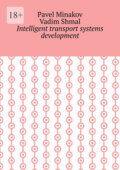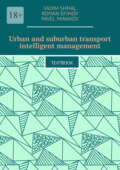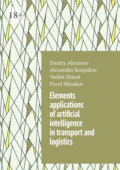
Vadim Shmal
Efficient technologies in railway transport
1.2 Vertical traffic control development based on scientific and technical achievements and informatization
Historically, the railway transportation process management system consisted of 4 levels: divisions of the Company’s central office – relevant services in the railway administration – departments in railway departments – railway stations. Each of these divisions, starting from the transportation services in the departments of roads, was in dual subordination: functionally – to the department of transportation Management, and administratively – to the heads of the railway and departments. Such a management mechanism led to contradictions in solving the company’s strategic tasks set at the central level and tactical ones at the regional level.
To eliminate these contradictions, the implementation of new solutions in the transportation process management system, on June 2, 2009, the Board of Directors decided to create a Central Directorate of Traffic Management – a branch of JSC “Russian Railways”.
The formation of a vertically integrated transportation process management structure in the context of the continuation of the structural reform of the development of the Russian Railways Holding corresponded to the target model of the railway transport services market approved in May 2007 at a meeting of the Government Commission on the Development of Industry, Technology and Transport.
The creation of the Central Directorate of Traffic Management (hereinafter referred to as the Central Directorate) completed the transition from a four-level train traffic management scheme to a three-level one, primarily due to the concentration of the dispatching apparatus of regional directorates, while interacting with the other directorates of the production unit, the Central Directorate concentrates in its hands the entire complex of functions related to the organization and management of transportation throughout their cycle.
In the context of the ongoing changes in the transport market, throughout the entire period of the Central Directorate’s activity, the technological tools used were constantly improved, the management system was consistently developed.
The centralization of train traffic management allowed for the introduction of end-to-end technologies and the application of landfill traction control principles.
It should be noted that the improvement of the management principles in the Central Directorate has allowed to create an effective structure that responds promptly to changes in the transport services market.
The development of a competitive sector in the field of freight car operations required new solutions to improve the efficiency of transportation. In this regard, the formation of park management technology has become the most important direction for the Central Directorate.
The result of this work was a Unified network technological process, which reflects the key principles of optimizing the use of rolling stock. In order to implement the technological solutions provided for by the unified network technological process, with the active participation of the Central Directorate, the necessary changes to the transport legislation were formed and initiated. Some of them have already been reflected in various regulatory legal acts.
The improvement of the technology and management system of the transportation process allowed the directorate to successfully fulfill the tasks set by the Company. After the completion of the branch formation stage, positive dynamics is noted in key volume and quality indicators.
Being one of the key divisions, the Central Directorate actively participated in the development of the Development Strategy of the Russian Railways Holding for the period up to 2030. Strategic initiatives have been developed to improve transportation activities, which provide for a whole range of production issues, and their implementation will give significant technological and economic effects.
Thus, in accordance with the control parameters of the state of the Russian Railways holding for the period up to 2030, one of the key indicators of the quality of the transportation process – the share of cargo shipments delivered on time – should be 95 percent.
The presented draft Program has been developed taking into account strategic initiatives in the field of transportation process management. It identifies five main vectors of development of the Central Directorate of Traffic Management, which are decomposed into consolidated measures to ensure their implementation.
The first vector is the transition from the regional principles of transportation process management to the planning and organization of train traffic at the landfills of the network.
As noted above, the work on the organization of the transportation process within the “polygons” has been carried out in JSC “Russian Railways” since 2012, since the creation of Traction Resource Management Centers. The positive experience of organizing the work of the locomotive complex in the new conditions confirms the need to consider the next stage of optimizing the transportation process by transferring train traffic management from the road level to the landfill.
It should be noted that there are currently several definitions of the term polygon. In particular, it is understood as a polygon of the road, the work of locomotives and locomotive crews, the following of heavy trains, etc. To form unified approaches to determining the polygon, boundary criteria, determining their optimal number, it is proposed to perform a number of scientific works in this section of the Program.
The main task that is being solved within the framework of the first section of the Program is the transition from the functional management structure to the construction of production cycles using the principles of the process approach.
Taking into account the existing experience in organizing the work of the locomotive fleet, in our opinion, the proposed management model will eliminate the losses existing at the junctions of roads, will provide additional consolidation of the work of all branches involved in transportation to meet the main quality indicators of work. This is extremely important at the current time, when it is necessary to ensure reasonable cost reduction and accelerated revenue growth for the holding.
One of the important activities of the Program section is the development of unified technological processes of landfills linking the work of the Dispatch Center for Transportation Management, the Traction Resource Management Center and other enterprises operating at the landfill. When forming them, the principles of the process approach will be widely applied, which allow optimizing the activities of the main production branches and eliminating individual technological operations that do not participate in creating value for customers and do not affect the safety, reliability and quality of management decision-making.
The transition to landfill principles of transportation process management will require updating the list of existing quantitative and qualitative indicators. Their new structure should determine not only the work of the landfill as a whole, but also the contribution of each directorate to their implementation.
The next step aimed at improving the efficiency of the transportation process is the development of uniform requirements for management facilities located at the landfill, which will ensure the through passage of trains of unified mass and length. It is under these requirements that it is necessary to form infrastructure development programs.
Improving the efficiency of marshalling yards is also one of the most important areas of the first block of measures.
Thus, in order to increase their processing capacity, in particular by eliminating recycling, it is proposed to form a program for the development of auxiliary – pre-node stations with the transfer of processing of local car traffic to them. To improve the efficiency of the port stations, it is proposed to form a comprehensive program for the development of the infrastructure of railway port stations and port infrastructure.
The second vector is the development and implementation of information technologies and modern technical means.
This is one of the most important sections of the Program, since at present it is the development of information technologies that directly affects the quality of the transportation process, from making operational decisions on the organization of transportation activities to providing an appropriate analytical base.
One of the priority tasks in the development of automated control systems for the transportation complex is the transition from information systems to information management systems. The implementation of the stated principles laid the foundation for a new project – an intelligent railway transport management system. The system under development provides:
– automation of the forecast of the use of network resources, with the coordination of throughput and processing capacities, as well as the technology of planning and management of traction resources, the development of technical standards of operational work;
– mutual linking of fully functional automated workplaces of employees of the Central Directorate;
– the transition from solving disparate tasks to interrelated calculations of the formation plan and train schedule, taking into account specific technologies.
That is, the whole complex of technologies for managing the transportation process.
The automated system for organizing the movement of trains on the high-speed Moscow-St. Petersburg route is already solving the tasks of monitoring compliance with the technology of passing high-speed SAPSAN trains. The successful experience of operating the automated train control system “ACS-D” during the Winter Olympic Games has shown the possibilities of solving problems of automation of dispatching control of train traffic and route preparation. During the Olympic and Paralympic Games, the train schedule exceeded 99% with an average daily circulation of more than 200 pairs of trains.
In the future, it is proposed to gradually introduce this system at all operating sites equipped with dispatching centralization, and with modernization and new construction, this requirement is now laid down in the technical conditions.
The largest port station Luzhskaya is implementing the most modern technologies and technical means, most of which will be implemented for the first time on Russian railways.
This is a dissolution management system that allows organizing the sorting process for one person (the person on duty on the hill), pulling up the cars in the sorting fleet, managing the locomotive without the participation of the driver, a special automated mode for the dissolution of wagons with dangerous goods, electronic document management.
The draft Program assumes the implementation of measures aimed at excluding a person from the process of securing rolling stock, inspecting trains, both commercially and technically.
Technological effects during the implementation of the second block of measures will be achieved by reducing the downtime of wagons at technical stations, increasing the speed of transportation, reducing the duration of paperwork at loading and unloading stations.
The third vector is the introduction of a comprehensive system of local work management aimed at improving economic efficiency.
In this section of the Development Program, measures have been developed for two directions – improving the efficiency of local work and reducing the unprofitability of inactive lines. They provide for the improvement of the technological processes of the stations, the transition to economic criteria for evaluating local work, the optimization of resources, the introduction of technology to ensure commercial reliability of cargo delivery for the entire route of their route.
As part of the ongoing work on the categorization of railway lines, it is proposed to revise the standards for the technical content of the infrastructure, optimizing them depending on the volume of cargo transportation.
As part of the optimization of the work of inactive lines, it is proposed to develop a program for combining professions, when in the target state, one of the employees of the locomotive crew must perform the duties of a receiver, a car inspector, a train compiler.
A similar combination of professions (electrician – station attendant) is offered when organizing the passage of trains and troubleshooting technical means.
The fourth vector is to increase the level of interaction between the vertical of traffic management and branches included in the business block “Railway transportation and infrastructure”.
Improving the efficiency of transportation process technologies is impossible without the development of cross-functional connections, their optimization and exclusion of inefficient ones.
In order to increase the level of block production activity and the level of customer orientation of the units that are part of the business block “Railway transportation and Infrastructure”, it is planned to develop regulations defining the order of annual and monthly planning, taking into account the existing infrastructure capabilities and carrying out the necessary repairs. It is planned to update the regulations of interaction between branches included in the business block “Railway transportation and infrastructure”, taking into account the end of its formation.
Since 2010, the company has been carrying out purposeful work to improve the system of material incentives for labor collectives, aimed at fulfilling the main strategic tasks to improve work efficiency through a system of bonus indicators and performance of production tasks.
Two years of work of the Regulations on the integrated crew of the marshalling yard have shown that the collective form of labor motivation is an effective tool for stimulating personnel to achieve their tasks, in which the amount of encouragement directly depends on the results of the work of all participants in the technological process. It is necessary to extend the provision on the integrated brigade to all marshalling yards of the network and solve a set of issues related to the development of a unified automated information system for monitoring the performance of bonus indicators for employees of integrated brigades and evaluating the performance of employees per shift.
The introduction of the Regulation on the integrated dispatching change of the railway is a qualitatively new round in the development of collective forms of labor stimulation, which is based on the competitive principle of dispatching personnel of the Directorate of traffic Management, infrastructure, track repair and other operational workers of the railway landfill, providing the transportation process within its borders.
In order to synchronize the tasks facing the collectives of linear stations and dispatching personnel, it is necessary to provide for uniform (end-to-end) bonus indicators in motivational schemes not only along the verticals of functional branches, but also other divisions included in the business block “Railway transportation and Infrastructure”.
The fifth vector is to increase the status of employees of the engineering unit in the implementation of the company’s priority tasks.
Today, one of the key success factors in solving the strategic tasks of the holding’s development and increasing labor productivity is the involvement of engineering workers in innovative and modernization processes taking place in railway transport. Specialists with the necessary professional and corporate competencies should act as carriers and conductors of innovative ideas that will form the basis of qualitative changes in the Russian Railways holding.
This ability must be developed in the employee throughout the entire period – from the moment of admission to the university until the end of employment directly at the enterprise. In addition, an important role is played by the process of employee satisfaction with the process of their work, the possibility of realizing their ideas in production.
To solve this set of problems, it is proposed to implement a number of measures, such as the introduction of new training standards, which will be directly linked to all the developments that are being carried out at Russian Railways. To identify the most promising employees and their business qualities, it is proposed to conduct evaluation activities. To exchange experience, create regional councils of engineers with periodic forums.
The implementation of the Program is aimed at achieving the strategic goals of the Russian Railways Holding. The economic assessment was carried out according to two development options – pessimistic and conservative.
In the conditions corresponding to the pessimistic scenario, the following targets are envisaged for the period up to 2030: an increase in the local speed to 41.0 km/h, the average weight of a freight train to 3,965 tons, locomotive performance of 2,057 thousand tkm. br., the share of shipments delivered within the regulatory (contractual) period of at least 91.7%.
The total accumulated (period 2015—2030) economic effect is estimated at 5.5 billion rubles (without the price factor in the working conditions of 2014, regardless of market conditions), including: 3.3 billion rubles. rub optimization of operating costs and 2.2 billion rub reduction of financial risks of making claims for late delivery of goods.
The implementation of the Program for the development of the vertical traffic control will lead to an annual optimization of the need for traction resources by improving the quality indicators of the use of rolling stock. To calculate the economic effect, the parameters of the dynamics of the average daily performance of the locomotive are used as a complex indicator that takes into account the dynamics of the local speed, the average weight of the train, the average daily mileage, the budget for the use of the locomotive, etc.
The total accumulated effect of optimizing operating costs by reducing the need for traction resources (to the level of the previous period) while increasing the average daily productivity of the locomotive to 2057 thousand tkm. gross (corresponds to the pessimistic scenario of the Development Strategy of the Russian Railways holding until 2030) is estimated at 3.3 billion rubles.
The implementation of the Transportation Management Vertical Development Program will lead to a reduction in financial risks for accrued claims for late delivery of goods when the delivery reliability level of 91.7% is reached by 2030 (corresponds to the pessimistic scenario of the development of the Russian Railways holding until 2030).
The total accumulated effect of minimizing financial risks on accrued claims for late delivery of goods while increasing the level of reliability to 91.7% (corresponds to the conservative scenario of the Strategy developed by the Russian Railways Holding until 2030) is estimated at 2.2 billion rubles.
The implementation of the Program in conditions corresponding to the conservative scenario of the development of the Russian Railways holding will allow achieving targets for the period up to 2030: increasing the local speed to 46.5 km/h, the average weight of a freight train of 4,200 tons, locomotive performance of 2,193 thousand tkm. br., the share of shipments delivered within the regulatory (contractual) period is not less than 95%.
The total accumulated (period 2015—2030) economic effect is estimated at 15.4 billion rubles (without the price factor in the working conditions of 2014, regardless of market conditions), including: 8.9 billion rubles – optimization of operating costs and 6.5 billion rubles. rub – reduction of financial risks of making claims for late delivery of goods.
The implementation of the Program for the development of the vertical traffic control will lead to an annual optimization of the need for traction resources by improving the quality indicators of the use of rolling stock.
The total accumulated effect of optimizing operating costs by reducing the need for traction resources (to the level of the previous period) while increasing the average daily productivity of the locomotive to 2,193 thousand tkm. br. (corresponds to the conservative scenario of the Development Strategy of the Russian Railways holding until 2030) is estimated at 8.9 billion rubles.
The implementation of the Transportation Management Vertical Development Program will lead to a reduction in financial risks for accrued claims for late delivery of goods when the delivery reliability level of 95% is reached by 2030 (corresponds to the conservative scenario of the development of the Russian Railways holding until 2030).







